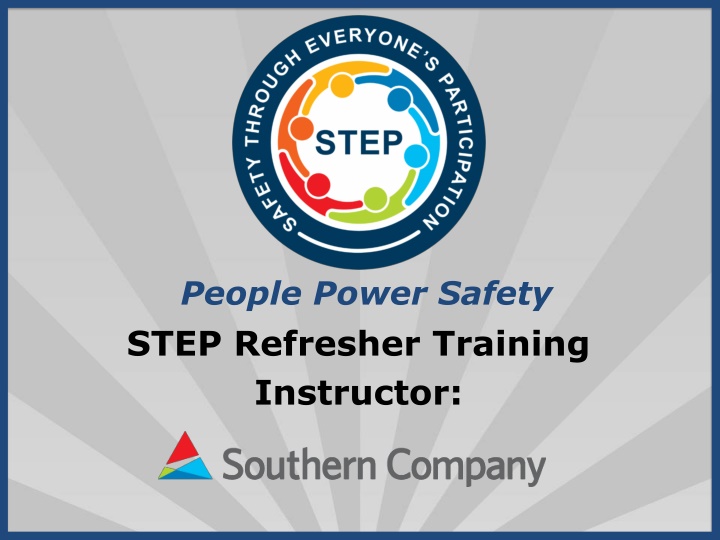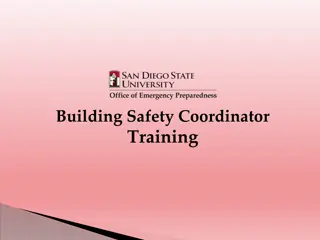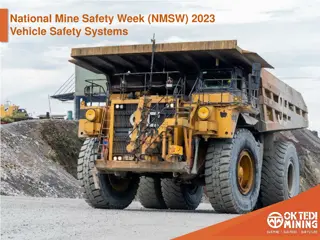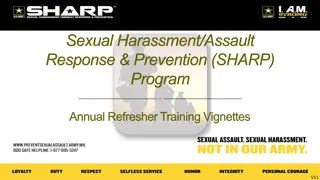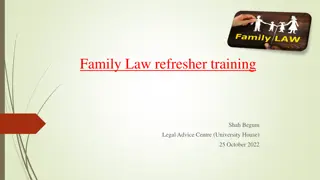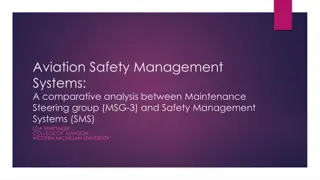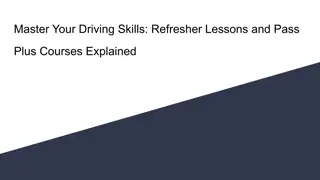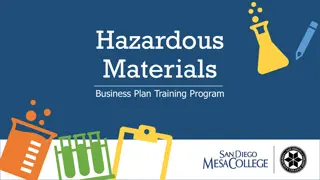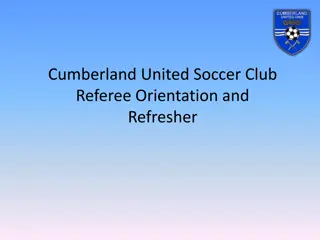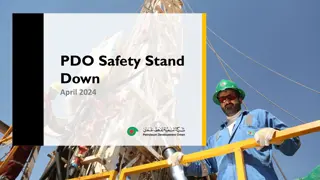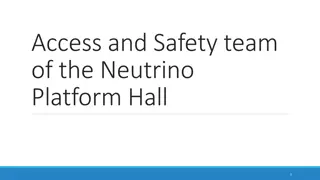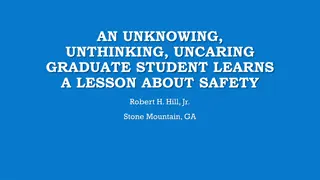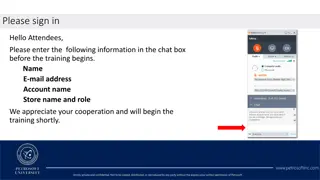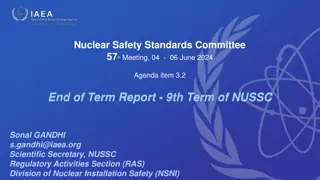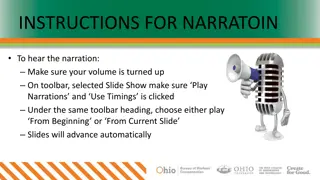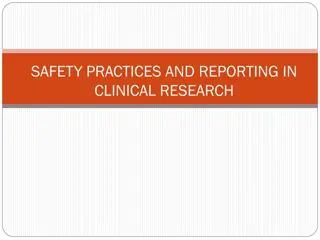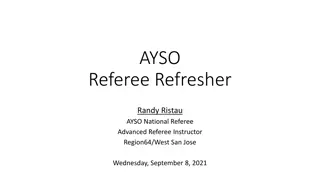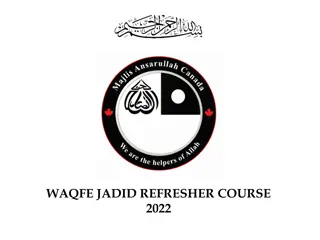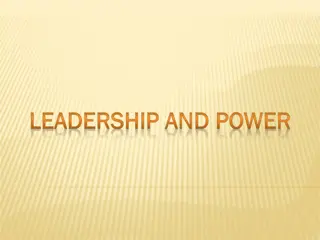Enhancing Safety: People Power SafetySTEP Refresher Training
Explore the comprehensive SafetySTEP Refresher Training program aimed at achieving safety through employee participation, engagement, and proactive safety measures. This training emphasizes creating a culture where safety is a core value, utilizing leading indicators to measure safety successes, and promoting internal accountability for safety. Gain insights on shifting safety perspectives, motivating safety practices, and understanding lagging indicators in safety performance evaluation.
Download Presentation

Please find below an Image/Link to download the presentation.
The content on the website is provided AS IS for your information and personal use only. It may not be sold, licensed, or shared on other websites without obtaining consent from the author.If you encounter any issues during the download, it is possible that the publisher has removed the file from their server.
You are allowed to download the files provided on this website for personal or commercial use, subject to the condition that they are used lawfully. All files are the property of their respective owners.
The content on the website is provided AS IS for your information and personal use only. It may not be sold, licensed, or shared on other websites without obtaining consent from the author.
E N D
Presentation Transcript
People Power Safety STEP Refresher Training Instructor:
Production Quality Safety
Agenda: STEP Purpose Engagement STEP Process Participation Data Use Plan Quality People Power Safety Predictive Solutions - Proprietary and Confidential
STEP Purpose We will achieve Safety Through Everyone's Participation. We will do this through actively engaging all employees to look out for the health and safety of each other. We will identify and prevent situations that could result in serious injury or the loss of a life. This information will be communicated on a regular bases with solutions and fixes. We will strive to have better safety conversations People Power Safety Predictive Solutions - Proprietary and Confidential
STEP Vision To create a dependable, repeatable method to measure safety successes using leading indicators instead of Recordable Injury Rate and Lost-Time Injuries. People Power Safety Predictive Solutions - Proprietary and Confidential
How do we Think about Safety? We need to shift our thinking: Safety is: Safety is: #1 Priority or Core Value? Can Change Instantly Changes Over Time People Power Safety Predictive Solutions - Proprietary and Confidential
How is Safety Motivated? Internal or External? (Responsibility) (Accountability) People Power Safety Predictive Solutions - Proprietary and Confidential
Accountability: After the fact Lagging Consequences Only when someone is watching! People Power Safety Predictive Solutions - Proprietary and Confidential
Definitions Lagging Indicators Measuring an organization s safety performance based on historical loss information Examples: OSHA Recordable Incidence Rates Lost Workday Case Rates First Aid cases Near Misses People Power Safety Predictive Solutions - Proprietary and Confidential
Responsibility: Before Leading Ownership What you do when no one is watching! People Power Safety Predictive Solutions - Proprietary and Confidential
Definitions Leading Indicators Measurable factors of performance that may indicate a particular direction or trend Examples: Job Hazard Analyses / Job Safety Analyses Observations Employee Perception/Safety Culture Survey Training Completion and Effectiveness People Power Safety Predictive Solutions - Proprietary and Confidential
We Want People to We Want People to Work Safely Work Safely Even Even When When No One is Watching! No One is Watching! People Power Safety Predictive Solutions - Proprietary and Confidential
Character is what we do when no one is watching Churchill People Power Safety Predictive Solutions - Proprietary and Confidential
Where do we start? Make it Personal Safety Step-Change Trust Active Caring People Power Safety Predictive Solutions - Proprietary and Confidential
We will create a positive change in our Safety Culture by Making Safety Personal because People Power Safety People Power Safety Predictive Solutions - Proprietary and Confidential
Why Should I work Safely? Who Would Care If I Was Injured? People Power Safety Predictive Solutions - Proprietary and Confidential
Active Caring Make it Personal Safety Step-Change Active Caring People Power Safety Predictive Solutions - Proprietary and Confidential
Active Caring Moving beyond simply caring to acting on that caring People Power Safety Predictive Solutions - Proprietary and Confidential
Completing the Triangle Make it Personal Safety Step-Change Active Caring Trust People Power Safety Predictive Solutions - Proprietary and Confidential
People Power Safety Predictive Solutions - Proprietary and Confidential
Trust Firm reliance on the integrity, ability, or character of a person or thing. What s Important for Safety Culture? Trust in Management: Trust in Coworker: Intentions Intentions Behaviors Behaviors People Power Safety Predictive Solutions - Proprietary and Confidential
Agenda: STEP Purpose Engagement STEP Process Participation Data Use Plan Quality People Power Safety Predictive Solutions - Proprietary and Confidential
Creating Employee Engagement Involvement vs. Engagement !!!
Why are Safe Behaviors Hard to Motivate? Consequences of Safe behaviors: Less Comfort Less Convenience More Time Consuming Consequences of At-Risk behaviors: More Comfort More Convenience Less Time Consuming People Power Safety Predictive Solutions - Proprietary and Confidential
What Motivates a Better Safety Culture? Environment Leadership Behaviors Core Values People Power Safety Predictive Solutions - Proprietary and Confidential
After STEP: We are Hurting Less People 3.5 3.19 3.15 3.0 OSHA Recordable Rate 2.44 2.5 2.06 2.0 1.62 1.57 1.5 1.261.090.95 STEPPROCESS 1.0 0.7 0.72 0.380.540.510.63 0.47 0.5 0.0 OSHA Recordable Rate for Construction Average = 3.8 People Power Safety Predictive Solutions - Proprietary and Confidential
But our Serious Injuries havent improved! SIIR Defined: (Krause & Murray, 2014) Life-Threatening Injury: - Significant loss of blood - Trauma to vital organs - Damage to brain or spinal column Life-Altering Injury: - Permanent or long-term impairment of loss of internal organ, body function, or body part SIIR = Serious Injury/Fatality Incident Rate People Power Safety Predictive Solutions - Proprietary and Confidential
Our Serious Injury/Fatality Incidence Rate is Gradually Increasing (SIIR) 2.0 Project RIR SIIR 0.7 0.72 0.63 0.7 0.6 1.5 0.51 0.5 .57 0.47 0.4 1.0 0.38 0.3 0.2 0.09 0.110.17 0.210.230.180.27 0.5 0.1 0.0 0.0 2010 2011 2012 2013 2014 2015 2016 People Power Safety Predictive Solutions - Proprietary and Confidential
Bottom Line: People are Still Getting Hurt we are not finished yet! WORLD CLASS Safety Improvement Best in Class Better Good Good We need a STEP-Change in our Safety Culture Great People Power Safety Predictive Solutions - Proprietary and Confidential
Agenda: STEP Purpose Engagement STEP Process Participation Data Use Plan Quality People Power Safety Predictive Solutions - Proprietary and Confidential
STEP Process Overview STEP is an observation and feedback process. It s all about the conversation! Work is observed feedback is then given on risky and safe behaviors, conditions & processes. Data is collected using checklists or mobile devices. The information is then analyzed, followed-up on, and communicated to everyone. People Power Safety Predictive Solutions - Proprietary and Confidential
STEP Process Overview We are NOT trying to catch people doing something wrong just have a conversation. We are trying to understand why people are doing something risky and how conditions could impact safety. Additionally, we are looking for things in the system that are allowing or encourage craft to do risky behaviors and thus change/improve the system. People Power Safety Predictive Solutions - Proprietary and Confidential
General Observations The General Observations section is used to enter any behavior, condition, or process not covered by the STEP observation checklist.
Feedback is a Key to Effective Leadership People have an internal drive to feel competent. Leaders behaviors (verbal & non-verbal) can impact craft future performance. Feedback can be a consequence and a powerful motivator. Both informal and formal recognition can motivate employees. Help them feel competent by giving quality recognition. Any recognition (negative & positive) you give send a strong message for future performance. Quality recognition can help build a teamwork atmosphere. People Power Safety Predictive Solutions - Proprietary and Confidential 37
We Need to Watch our Language To change the way people think about safety, you have to talk differently about safety: Achievement not failure oriented Use At-Risk or Risky not Unsafe or Wrong: That looks risky to me, help me understand why you or I think you re putting yourself at-risk for an injury vs. That s unsafe. What the ~*#@% are you thinking?! or That s wrong you %$*& , let me show you the right way! People Power Safety Predictive Solutions - Proprietary and Confidential
Choose Your Word Carefully We want to create a safety conversation, not a one-way top-down communication! When talking safety, stay away from words like: Bad: That s really bad, what are you thinking? Improper: That s the improper way of holding that wrench Wrong: What s wrong with you, that s not how we do it? Inappropriate: Those clothes are inappropriate for the job Or use rules as a easy out: You know it s against the rules, you re gonna get us all fired? People Power Safety Predictive Solutions - Proprietary and Confidential
When Giving Rewarding Feedback Try to make it personal: I appreciate how safely the team is getting things done Never just say good job use a behavior: Hey, good job using a team lift Try to build their confidence or competence : You guys are a bunch of professionals most of the time! Use humor sparingly or in a non-degrading way: Hey, you re no Marino don t toss wrenches! Give feedback one-on-one, or in front of a group if the person is okay with that. People Power Safety Predictive Solutions - Proprietary and Confidential
What is Your Level of Listening? Marginal Evaluative Active Empathic Non- listener Listener Listener Listener Listener People Power Safety Predictive Solutions - Proprietary and Confidential
Improve Your Listening Skills 1. Pay Attention focus on content, not delivery 2. Respond seek clarification, question, paraphrase 3. Let speaker finish don t prepare what to say next 4. Main Ideas facts, feelings, values, opinions 5. Eye Contact focus on the speaker, not your watch People Power Safety Predictive Solutions - Proprietary and Confidential
Pre-Observation Thoughts Who will your focus be on? What do you expect to see? When would be the best opportunity to observe? Where would my observation and communication make the biggest impact? People Power Safety Predictive Solutions - Proprietary and Confidential
Conducting Behavioral Observations Focus on behaviors what you see people doing. Do NOT focus on rules/regulations or Policies. Mark all behaviors you see Safe or At-Risk. Record the severity of the risky behaviors. Identify any Error Traps and record them Record comments to clarify what you observed. Give feedback on both safe & at-risk observations. People Power Safety Predictive Solutions - Proprietary and Confidential
Conducting Compliance Inspections Proceed to the predetermined location. Focus on conditions around you. Mark all conditions on the checklist Safe or At-Risk. Record the severity of the risky conditions. Identify any Error Traps and record them Record comments to clarify what you observed. If employees are present, give feedback on both safe & at- risk. People Power Safety Predictive Solutions - Proprietary and Confidential
Define Severity - Exercise Probability Low High Low Low Medium Severity Life Threat High High People Power Safety Predictive Solutions - Proprietary and Confidential
Agenda: STEP Purpose Engagement STEP Process Participation Data Use Plan Quality People Power Safety Predictive Solutions - Proprietary and Confidential
STEP PARTICIPATION Improve Safety Culture through STEP observations and safety conversations Safety Teams conduct observations Monitor observation quality STEP data communication IAW Data Use Plan Improve contractor engagement / awareness Improve Leadership engagement conversations Conduct Focused Observations based on the data Reduce probability of serious injuries & fatalities People Power Safety Predictive Solutions - Proprietary and Confidential
STEP Process: Participation Expectations Everyone will participate IAW management guidelines. Participation can be individual, in pairs or in a group. Each person will schedule their participation. For instance: Every Tuesday and Thursday Two for Tuesday will be my Paired Observation The team will schedule each day (AM / PM). Based on the weekly look back/ahead, select a location, contractor, task, or floor as your target. Complete the observation or inspection on paper or in the SafetyNet app immediately following the participation. People Power Safety Predictive Solutions - Proprietary and Confidential
STEP PARTICIPATION Who will do STEP Observations? EVERYONE! All Southern Company staff included but not limited to: Plant Manager, Managers, Supervisors, Safety Committee, & Contractors How many STEP observations are required? Weekly, monthly, or quarterly observation rates will be determined by management. (Ex. Two observations per week) Who do we observe? Anyone in our work areas. Do I have to give feedback? YES! Feedback should be given to the person/s observed when appropriate. ANYONE HAS THE RIGHT TO STOP AT RISK BEHAVIOR!
